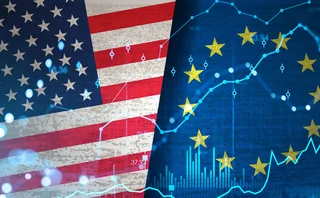What to Do About Mifid II
Europe’s regulatory big bang arrives today as an evolving set of rules rather than a finished product.

The clock—sent out by Tradeweb to trade and newspaper outlets—signifies the implementation of the revised Markets in Financial Instruments Directive, or Mifid II, some of the most comprehensive reform of trading rules in the history of the financial markets. Today is the day that it goes live.
Any number of reasons have brought us to this point, such as the explosion of high-frequency trading (HFT) among the new markets and the old that were birthed by the original Mifid in 2007, through to the implementation of post-crisis agreements to move, as far as possible, risky derivatives trading away from an over-the-counter basis to an on-venue practice.
As with any massive piece of regulation, elements have been praised and derided, controversy has been generated and settled, and early winners and losers emerged. The exchanges, in particular, are likely the beneficiaries of most of the rules around trading on-venue and new reporting requirements, while the buy side is finding itself—in some cases, for the first time—under the regulatory magnifying glass.
In many ways, however, Mifid II represents the changing form of regulation itself. In interviews with WatersTechnology, senior regulators, including Steven Maijoor, the chairman of the European Securities and Markets Authority, have said that they do not see a Mifid III in the immediate future. Rather, they have stressed, Mifid II is an organic document. It will evolve to adapt to market developments as far as possible through regulatory guidance, the issuance of Q&As, and the national-level implementations by regulators.
But the market has already changed dramatically since 2014, when the first draft of technical standards was released. In that time, the importance and impact of HFT have lessened, while new technologies, such as distributed ledgers and an ongoing explosion in the use of artificial intelligence, present new opportunities, and new risks. Politically, the departure of the United Kingdom from the European Union, scheduled at present for March 2019, may well prove to be the fulcrum on which the efficacy of Mifid II—and European markets as a whole—begin to turn.
As such, despite assurances that Mifid III is not on anyone’s docket for 2018, it’s hard to imagine that questions are not being asked in Brussels and Strasbourg around how rules designed for a different time can be flexible enough to incorporate such radically different potential futures.
Herein, of course, lies the difficulty in regulating financial markets in the modern age. Patchwork regulations designed to solve specific problems face a torturous path through the EU’s Lamfalussy process, which means they often arrive after the horse has bolted the stable, while the impossibility of putting in place no-action mechanisms under that same process means regulators are forced to, in some instances, simply turn a blind eye to non-compliance. National regulators, of course, have the ability to grant deferrals—as seen today by the Intercontinental Exchange’s announcement that it has received a 30-month exemption from open-access rules under Mifid II from the FCA and the Bank of England—but these are not commonly used.
This is the new status quo, as technology, in many ways, becomes the markets. The industry’s ability to innovate—by its very nature—outstrips the capacity of watchdogs to understand and legislate appropriately. Regulators have adopted a pragmatic wait-and-see approach to many new technologies, but all the case studies, feedback statements and Financial Stability Board reports in the world can’t substitute for solid guidance.
This question becomes even more pertinent as we look past Mifid II, which has consumed so much of the industry’s efforts in recent years. With the advent of technological sophistication through machine learning and AI that can bamboozle even its inventors, and the enormous social, technical and political challenges that may be posed by the advent of quantum computing, there is a disconnect between innovation and oversight that simply must be addressed.
In the short term, of course, the focus will be on Mifid II—and if the various surveys that litter the inboxes of industry reporters are any indication, there is still a large hill to climb before people are ready to comply.
But there should be an honest reckoning about the important questions that Mifid II’s painful birth has generated, not just for regulators and lawmakers, but for the industry, too, and how it balances its forward motion with responsible growth.
Our global coverage of implementation day:
- Kirsten Hyde explores how US firms are preparing defenses against Mifid II for Inside Market Data.
- News editor James Rundle on the weaknesses in the regulatory process exposed by Mifid II’s painful birth.
- For many technology personnel, Mifid’s January 3 implementation meant it wasn’t a festive holiday period.
- WatersTechnology’s reporters in New York and London on implementation day.
- Aggelos Andreou sits down with Esma chairman Steven Maijoor to discuss Mifid II, and maybe Mifid III.
- Inside Reference Data digs in to Esma’s shock announcement of a grace period for identifiers, weeks after one of the main issuers began offering a “same-day” service for a 50 percent markup.
- Our reporters in New York and Hong Kong find that problems might be stacking up for Mifid II compliance in the future, particularly in Asia-Pacific.
- WatersTechnology hosts a webcast on some of the surveillance challenges surrounding Mifid II, featuring Nasdaq, Mana Partners, CIBC and Digital Reasoning.
- Our guide to the key areas that will be affected by Mifid II and EBR.
Only users who have a paid subscription or are part of a corporate subscription are able to print or copy content.
To access these options, along with all other subscription benefits, please contact info@waterstechnology.com or view our subscription options here: https://subscriptions.waterstechnology.com/subscribe
You are currently unable to print this content. Please contact info@waterstechnology.com to find out more.
You are currently unable to copy this content. Please contact info@waterstechnology.com to find out more.
Copyright Infopro Digital Limited. All rights reserved.
As outlined in our terms and conditions, https://www.infopro-digital.com/terms-and-conditions/subscriptions/ (point 2.4), printing is limited to a single copy.
If you would like to purchase additional rights please email info@waterstechnology.com
Copyright Infopro Digital Limited. All rights reserved.
You may share this content using our article tools. As outlined in our terms and conditions, https://www.infopro-digital.com/terms-and-conditions/subscriptions/ (clause 2.4), an Authorised User may only make one copy of the materials for their own personal use. You must also comply with the restrictions in clause 2.5.
If you would like to purchase additional rights please email info@waterstechnology.com
More on Regulation
Banks split over AI risk management
Model teams hold the reins, but some argue AI is an enterprise risk.
New EBA taxonomy could help banks track AI risk
Extra loss flags will allow banks to track transversal risks like geopolitics and AI, say experts.
Risk managers question US reach of Dora third-party list
Some EU subsidiaries included, but regulator control over cloud providers could still be limited.
Where have four years of Cusip legal drama gone?
The IMD Wrap: The antitrust case against Cusip Global Services has been a long, winding road. Reb recaps what you might have missed.
2026 will be the year agent armies awaken
Waters Wrap: Several AI experts have recently said that the next 12 months will see significant progress for agentic AI. Are capital markets firms ready for this shift from generative AI to agents?
Despite regulatory thaw in US, major questions remain globally for 2026
From crypto and tokenization to the CAT to consolidated tapes to T+1’s advancement, the regulatory space will be front and center in the New Year.
Will overnight trading in equity markets expand next year? It’s complicated.
The potential for expanded overnight trading in US equity markets sparked debate this year, whether people liked it or not.
Waters Wavelength Ep. 342: LexisNexis Risk Solutions’ Sophie Lagouanelle
This week, Sophie Lagouanelle, chief product officer for financial crime compliance at LNRS, joins the podcast to discuss trends in the space moving into 2026.







